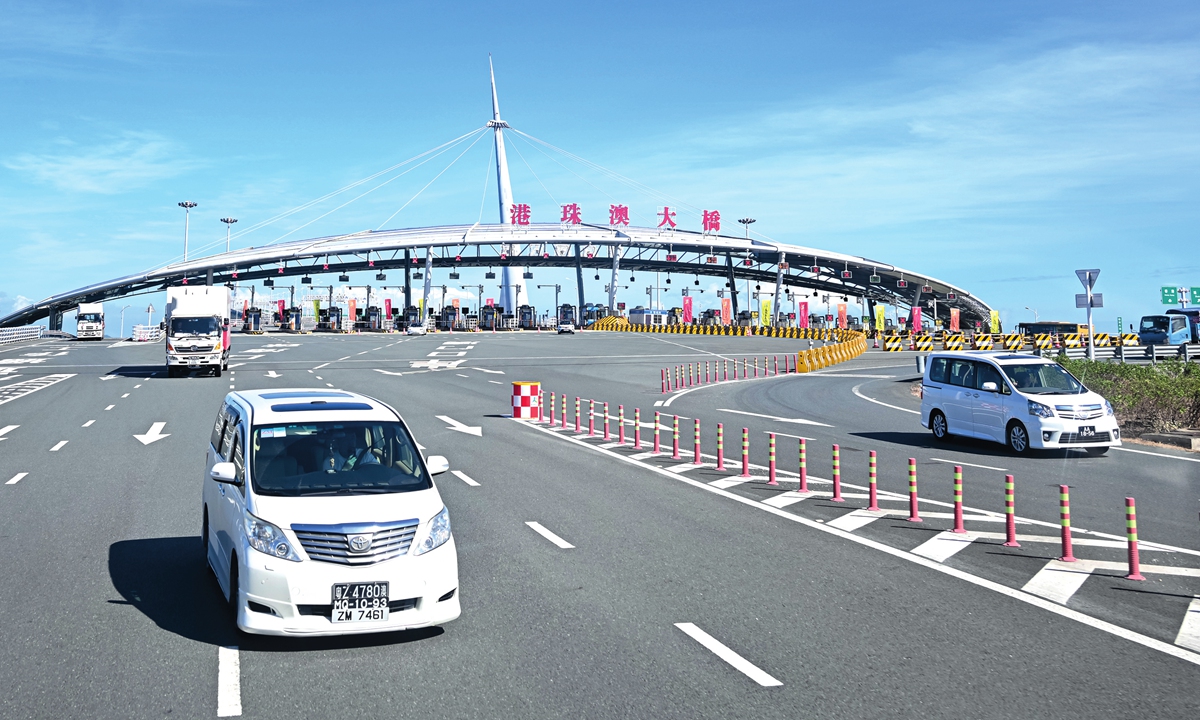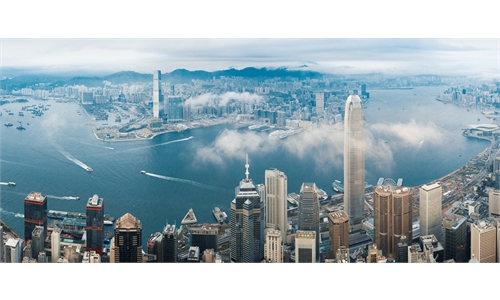Northbound travel from HK, Macao to Chinese mainland popular, convenient as one-hour living circle within GBA realized

A view of the Hong Kong-Zhuhai-Macao Bridge Photo: VCG
"If you depart from Hong Kong at 9 am, you can enjoy a dim sum brunch in Zhuhai (South China's Guangdong Province) at 11 am after a drive of no more than two hours," a resident surnamed Luo from Hong Kong Special Administrative Region (HKSAR) told the Global Times on Sunday.
And after a relaxing day of going shopping and getting a massage, you can sleep in your own bed at home in Hong Kong, Luo said.
She noted that the journey from her home to Zhuhai takes a similar amount of time as going to places like Causeway Bay in the Hong Kong city center, sometimes even shorter.
Luo's one-day tour has become more and more common among residents in the Guangdong-Hong Kong-Macao Greater Bay Area (GBA), as the "one-hour living circle" has been realized.
Facilitation measures
One of the facilitation measures is the Quota-free Scheme for Hong Kong Private Cars Traveling to Guangdong via the Hong Kong-Zhuhai-Macao Bridge (HZMB), effective from July 1, 2023, under which private cars will be exempted from paying custom duties.
The northbound travel program took effect on January 1, 2023 for Macao. This program is one of the important measures taken by the central government to support the development of Hong Kong and Macao and promote the construction of the GBA.
The program, which is part of the measures to promote connectivity within the GBA, had witnessed over 500,000 vehicle trips by single-plate car owners from Hong Kong as of Saturday, according to the border checkpoint of HZMB.
The average monthly customs clearance of eligible vehicles from Hong Kong to Guangdong currently reaches 95,000 vehicle trips, which is 13 times higher compared to half a year ago when the northbound travel program was first implemented.
A total of 88,000 northbound vehicle trips were made by Hong Kong and Macao residents during the 2024 Spring Festival holidays (February 10-17), accounting for 70 percent of the total vehicle trips, according to HZMB customs data.
The Northbound Travel for Hong Kong Vehicles is a policy breakthrough, as stated by Lam Sai-hung, secretary for transport and logistics for the HKSAR government, in December 2023 on HKSAR government's website.
"The policy facilitates Hong Kong residents' self-driving to Guangdong for business, visiting families or sightseeing on a short-term basis," Lam said.
The transport and logistics secretary also noted that the program enables residents to embrace the opportunities brought by the HZMB, facilitating further connection among cities in the GBA and promoting economic development and integration within the area.
Enhanced Connectivity
The convenience has made northbound travel increasingly popular among Hong Kong and Macao residents.
About 1.16 million northbound passenger trips from Hong Kong to the Chinese mainland were made during February 9-13, accounting for 70 percent of Hong Kong's outbound travel during the period, according to data from the HKSAR Immigration Department.
"In fact, more often than not, Hong Kong residents prefer to go to Shenzhen (in Guangdong) or other cities in the mainland to experience their charm first-hand," Choi Wun-lam, a 27-year-old Hong Kong local who works in Shenzhen, told the Global Times in a previous interview.
On weekends or during holidays, nearly half of the crowds at Shenzhen's night markets and restaurants near the Shenzhen border are people from Hong Kong, Choi said.
Meanwhile, southbound travel has also boomed thanks to improved infrastructure connectivity. During the Spring Festival holidays in 2024, a total of 1.436 million passenger trips from the mainland to Hong Kong were completed.
The more frequent exchanges should be partly attributed to the well-developed and convenient transport network in the GBA. By the end of 2023, about 60,000 kilometers of highways are open to traffic in the GBA, with a density of 9.7 kilometers of expressways per 100 square kilometers. The length of railway in the GBA exceeds 2,700 kilometers.
Analysts noted that with facilitation measures and more completed transportation networks, the connectivity of the city cluster makes it much more convenient to travel, study and work, Liu Guohong, director of the Department of Finance and Modern Industries at China Development Institute in Shenzhen, told the Global Times.
"More importantly, the integrated development of cities within the GBA strengthens the advantages of the region, which boasts a competitive international financial center, trade center, shipping center and strong innovation corridor," Liu said.
China unveiled the outline development plan for the GBA in February 2019, aiming to develop the region into "a role model of high-quality development."
According to the plan, China has vowed to build the GBA into a vibrant world-class city cluster, a globally influential international innovation and technology hub, and a quality living circle for living, work and travel.
Over the past few years, the central government has adopted a series of concrete measures to make it more convenient for residents from Hong Kong and Macao to study, work or live in the Chinese mainland.
Five years on, more than 600 measures have been announced to turn the blueprint into reality, and the economic output of the GBA is estimated to have exceeded 13.6 trillion yuan ($1.9 trillion) in 2023, said Zhu Wei, deputy director of the Development and Reform Commission of Guangdong Province, in February.
Analysts noted that integration and connectivity between cities in the GBA have greatly improved over the past few years due to a variety of supportive policies and measures aimed at strengthening cross-border links in diverse fields, bringing benefits to businesses and individuals in the region.
The development of Hong Kong and Macao will be further integrated into the GBA, taking advantage of the opportunities and benefits of the Chinese mainland's steady development, Liang Haiming, an expert on the Hong Kong economy and chairman of the China Silk Road iValley Research Institute, told the Global Times.

